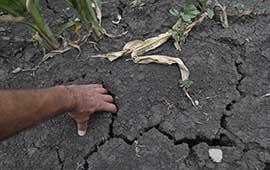2020 has become a real test for the whole world.
In addition to the coronavirus pandemic, the countries also faced an unprecedented drought, as a result of which significant losses were observed in the agricultural sector. And this natural phenomenon has not spared any country, which, of course, affected the decrease in the number of various crops and the decline in exports.
Losses in the agricultural sector from drought in 2020
From the very beginning of 2020, experts predicted instability in the agricultural sector.

Already from the corn start in the USA, it was clear that the weather factor, by and large, became the only one that a person cannot control. At the same time, even experts could not predict that the northern hemisphere would be hit so badly by the drought. In addition, at least in the corn market, the situation with stocks was spoiled by China, which decided to import almost all the remnants of this crop, which caused the world to face a shortage of it. At the same time, over the past year, only from Ukraine exported 1.8 million tons of corn, which is the average monthly figure for the previous 8-9 years. However, experts explain that such indicators were the result of the active work of the so-called “gray market”, which, even during the crisis, did not slow down trade.
The EU countries and Ukraine, however, suffered from weather conditions no less – the yield of all forage crops decreased. The “hole” appeared in the wheat market, and according to forecasts, it will only get worse if oil prices rise. Due to the drought, the yield of crops that are used for animal feed, in many cases, reached only 40% -60%, which also affected the supply of these crops to other countries. Let’s analyze the situation using the example of Ukraine, which is traditionally one of the main suppliers of grain and oilseeds to European markets.
So, of the grain received, the yield of which was kept at the level of 65 million tons, only a quarter went to the needs of the local population, the rest was exported. In 2020, more than 50 million tons of Ukrainian grain were sent to other countries. Therefore, as we can see, even such a weather feature as drought could not stop local entrepreneurs from trading on international platforms. It should be noted that Europe, even during the crisis years, was strictly related to the documents for imported products, and therefore local farmers were forced to take these features into account when delivering abroad.

How farmers fought the drought
Contrary to the most sad expert forecasts (some even promised hunger because of unfavorable weather), the farmers still survived this crisis year. Many, of course, had to simply abandon the idea of growing certain crops, for example, a sunflower, since frost followed by drought completely neutralized the pesticides and fertilizers introduced into the soil. Other farmers were forced to re-sow winter crops, which were exposed to frost and simply did not emerge.
To cope with the drought, farmers have also had to choose weather-resistant varieties or crop hybrids that will sprout even with minimal rainfall. In addition, timely pre-sowing soil cultivation and proper use of the land, which would help to retain moisture, came to the fore. For example, some farmers abandoned stubble burning and carried out additional soil treatments. Thanks to these requirements, in some regions of Ukraine, it was possible to grow a high-quality crop, the indicators of which remained at the level of last year even during the crisis.






